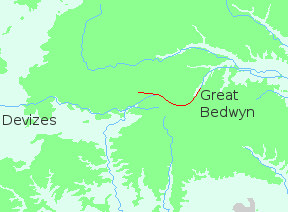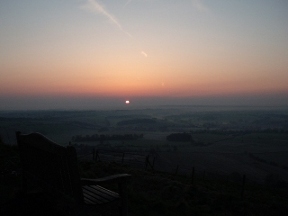
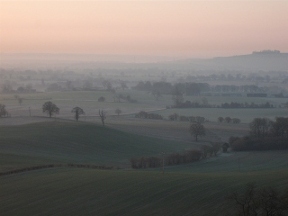
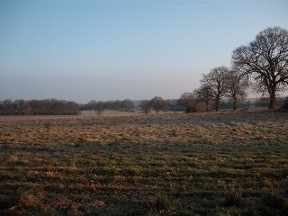
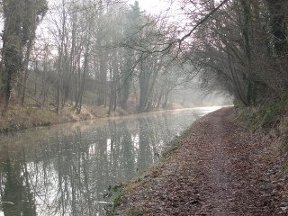
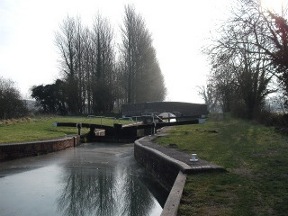
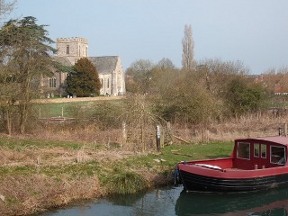
That night I slept soundly in spite of the cold. I was well wrapped up and the flysheet kept off the chill air. At first light I awoke and scrambled out to see the dawn.
I stood on the edge of the escarpment where the ground plunges four hundred feet to the valley floor. A slight breeze wandering over the ridge froze the breath in my nostrils. Slowly the eastern sky flushed red, warming the heights. Far below the villages lay in darkness. In the frost-whitened fields nothing stirred. Then as the ponderous sun rose though the mist night was transformed. Light and colour flooded the world and a new day was born.
There are some moments which are a revelation. They happen at odd times, when the mind is still and unburdened with the cares of existence. Then things appear as they really are. Everything makes sense. Life becomes for a while such a simple thing, and it is a privilige to be part of it.
It was too cold to admire the view for long so I packed quickly and set off. The path wound round the ramparts of the hill fort, through patches of woodland where frost-hardened leaves crunched pleasantly underfoot. In the clear sky the sun shone. The air was fresh, and the grass sparkled. A fine morning to be out and about.
At Martinsell the high chalk separating the upper Kennet from the Vale of Pewsey comes to an end. The ground falls steeply to a low ridge running east. A path called Mud Lane follows the ridge - and yes, it is very muddy! While the upper chalk is often quite dry the lower beds may be adulterated with clay, preventing the winter rains from draining away. For the first half mile I was glad I was wearing wellingtons, but after that the going improved and I could stop watching for puddles and look about me. I was now walking through farmland; a pleasant, uneventful landscape. That morning it suited my mood. The way was easy to follow, there were no climbs - nothing to do but amble along enjoying the sunshine. A fox emerged from some bushes and crossed the path, unaware of my presence.
At Hat Gate I turned right and rejoined the Kennet and Avon not far from Burbage Wharf. Half a mile further on the canal passes through a tunnel and enters a cutting. This is the highest point on the K and A. From here it's downhill all the way to the sea - if you can call a drop of five hundred feet in one hundred miles downhill.
I stopped for breakfast near one of the locks, where a channel carries away the overflow from the canal. As I sat there I noticed something moving among the reeds, then out onto the concrete lip of the drain came a mink. Some of these vicious predators escaped from fur farms; others were deliberately set loose by animal rights lunatics. Though they have established breeding colonies it was recently reported that their numbers are falling, perhaps due to the reintroduction of the much larger otter. Otters can now be seen in every county in England and when it comes to fish they don't like competition!
Soon I came to the Crofton Beam Engines. The engines, still working, were designed to replenish the water in the upper reaches of the canal. From there it would gradually drain away as boats navigated the locks. On the K and A, which passes through the dry chalk uplands, water is still a problem.
At Crofton the canal swung sharply north-east and there were a couple of uneventful miles to Great Bedwyn. Not really part of the route, but I had to get there as it's the only railway station in the area. While waiting for the train I looked back on another and very memorable stage. The next would take me over Inkpen and along the Wayfarer's Walk to Kingsclere.

